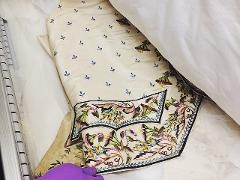Behind the scenes: In our collection store with Catriona Wilson, Collections Manager
Our collections team spends several days every week in the stores working alongside a trusty band of volunteers to carry out a full-scale inventory of the collection. This project has been running for a few years now, beginning with the archaeology collection (our largest collection) and moving onto Local History in 2016.

To date we have recorded the contents of around 6000 boxes and shelves, representing something in the region of 100,000 objects and groups of objects. We have recently begun to inventory our needlework collection.

How did you end up working for Guildford Museum?
I joined the Guildford Heritage team in 2013 after around seven years of curating medical museums in Worcester (and studying archaeology and museum studies at Durham before that).

I was lucky to be able to fundraise for and then build a new, permanent museum about Worcester's 17th Century infirmary along with the University of Worcester.
The museum is called The Infirmary and opened just before I came to Guildford in 2013. I am very proud of how well it is doing under my successor, Mark McCleod.
I took the difficult decision to move in order to be able to live with my partner, and was fortunate and very excited to get this job, not least because I was finally able to put my archaeology degree to good use.
What is the collection policy for the museum? Are we collecting everything and anything?

Our collecting policy focuses on a few key areas, specifically: archaeology, local history, art, and needlework.
The collection includes items from across Surrey plus a few examples from as far afield as Turkey, Egypt and Canada.
In general, we now use the borough boundary as our collecting area, though our needlework collection continues to be worldwide as it was started as a reference for all aspects of technique and equipment.
We have a collecting panel that meets every two months, which considers all offers very carefully against significance, condition and storage space, plus a few other issues.
Because our stores are so full, we aren't able to collect as much as we might like. We have to make very careful decisions over the objects we are offered and only accept the most significant objects or archaeological archives.

To give an example, we recently acquired two Medieval cloth seals from Guildford - evidence of the very important Medieval wool trade in Guildford (examples of which can be seen on the town crest with its two woolpacks either side of the tower).
These are extremely rare, and represent a significant part of the story of the town.
The larger seal has the word 'GULDEFORD' around the edge, and the smaller one shows the castle gatehouse of the town crest.
The oldest object in the collection is....

Aside from some pieces of our (very small) geology collection, some of which can be millions of years old, the earliest human-made objects are the Paleolithic handaxes.
These are somewhere between 500,000 and 300,000 years old, and handling them always sends a tingle down my spine.

Conversely and perhaps surprisingly, one of the 'youngest' objects in our collection is a Nokia mobile phone owned by a Guildford teenager in the early 2000s. I had one of these myself!
Highlights of your job are...
Hands down, the best part of my week is working in the store every Thursday with my volunteers. This work is quiet, methodical and concentrated with wonderful object surprises every single week. It has allowed the collections team to get a really good overview of the collection, and is a very satisfying project because we have found quite a few objects believed to be lost for some time.

I often think of it as an exercise in mindfulness as we focus on one specific task for several hours at a time without any distraction, and at the end of each day, we have achieved something concrete.
I go home pleasantly tired from lifting boxes and focussing on one concerted task, and I always sleep beautifully!
I greatly enjoy the variety of working with such diverse collections - no two days are the same. In the last few months, I have dealt with enquiries relating to musical instruments, human remains, sculptures, watercolours by Henry Sage, several loan requests from other museums and groups, and Roman samian ware makers' marks, among others.
The ability to let myself into the stores to spend time with collections continues to feel like a privilege, and I hope I never lose that thrill. Even better than this are all the opportunities that we make to invite others into the stores as well to share this excitement. I remember reading a speech by an early National Trust director that said (paraphrased):
Access without conservation is impossible; conservation without access is pointless.
This sums up what my role as collections manager means to me: I am here to safeguard the collections to ensure that they are available for future generations, but they must be made available wherever possible otherwise everything I do is without purpose.
Catriona Wilson works with her volunteers in the store every Thursday. Our #FindsFriday posts on Facebook and Twitter are examples of the weird and wonderful objects that Catriona and the volunteers come across while inventorying. Stay tuned and follow us on: Twitter: @Gfdheritage (opens new window), Facebook @VisitGuildford - Guildford's Heritage (opens new window).
